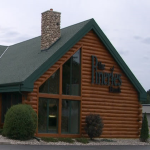|
Just had U-verse fiber installed. gently caress them for using amber LEDs for gigabit and green for 100Mbit on the modem. That was a delightful monkey wrench in troubleshooting. Also looks like the UniFi switch does not play well with their IPTV. It would play a feed for ~10 seconds then barf and say connection lost. Wired it directly to their modem and will have to revisit later.
|
|
|
|

|
| # ? May 30, 2024 13:39 |
|
Attempting to set up my new TP Link C5 today - shouldn't I be able to use the same static IP settings for subnet mask, default gateway, primary DNS server, etc. that I screenprinted from my old router's config page? I tried to use all the same settings and I couldn't get it to connect to the internet. All the FAQs and guides I am reading say to "enter the settings provided by your ISP" and mine is municipal which means they are closed today. It's not a huge deal since I can just use my old router until Monday but it would be great if I could get the new one set up while I have the time today. I'm not super great with this stuff so any help is appreciated.
|
|
|
|
owl_pellet posted:Attempting to set up my new TP Link C5 today - shouldn't I be able to use the same static IP settings for subnet mask, default gateway, primary DNS server, etc. that I screenprinted from my old router's config page? I tried to use all the same settings and I couldn't get it to connect to the internet. All the FAQs and guides I am reading say to "enter the settings provided by your ISP" and mine is municipal which means they are closed today. It's not a huge deal since I can just use my old router until Monday but it would be great if I could get the new one set up while I have the time today. I'm not super great with this stuff so any help is appreciated. Are you talking about the IP your ISP gives to your router? Most of the time you leave the wan settings on DHCP unless you specifically have a static IP as part of your package.
|
|
|
|
GobiasIndustries posted:Are you talking about the IP your ISP gives to your router? Most of the time you leave the wan settings on DHCP unless you specifically have a static IP as part of your package. The TP Link quick setup wizard asks me to select my WAN connection type and gives me the options dynamic, static, PPPoE, L2TP, and PPTP. The wizard auto-detects my connection type as static which I guess makes sense since I have fiber. When I select static it wants me to enter in all that additional stuff like subnet mask, default gateway, etc. I tried going through the wizard having selected dynamic just to see what happens and that didn't work either.
|
|
|
|
The Midniter posted:It's the same TWC modem from when I moved into my last place, so I'd put it at just under two years ago. I just connected the same modem to the different coax connections in the house until I found one that had a signal. If you can get a continuous coax line from source to destination then you should also look into MoCA adapters, they can run at Ethernet-like speeds.
|
|
|
|
owl_pellet posted:The TP Link quick setup wizard asks me to select my WAN connection type and gives me the options dynamic, static, PPPoE, L2TP, and PPTP. The wizard auto-detects my connection type as static which I guess makes sense since I have fiber. When I select static it wants me to enter in all that additional stuff like subnet mask, default gateway, etc. I tried going through the wizard having selected dynamic just to see what happens and that didn't work either. I figured it out. I don't know why the new router was detecting my WAN connection as static, but the settings on my old router were for DHCP (dynamic). I had to release the connection on my old router, hook up the new router, and renew the connection from there. It auto-detected the new settings immediately and set them to what I was trying to set them to manually based on the old router's settings.
|
|
|
|
How could I improve wifi in my apartment? It's 7x10 meters with 4 rooms. Walls are made from steel-reinforced concrete. I have two 20€ zyxel 2,4ghz wifi boxes. One in bottom left room, one in bottom right. Even when I am next to a router, often streaming from Twitch is very laggy. If I use my phone's 4G there are no problems. Layout looks like this: https://hakkarainen.kuvat.fi/pics/varamiespalvelu.png How many wifi boxes I need? Where should I put them? Which rooms, to a wall, roof, on the table, ? I thought about Unifi AC Pro's. I have an ER Lite already so they would fit in the theme.
|
|
|
|
wormil posted:I used a 655 for years, great router, 2.4 only IIRC. Range improved considerably with longer antennas. The experiment didn't last long. With less than 10 connected devices it began booting some off or wifi going down all together. What could I try to fix that? And what can I do to increase transfer speeds across my network? Not hitting 10mbps transferring files from my desktop here to a laptop, both hard wired at 1gbps.
|
|
|
|
owl_pellet posted:I figured it out. I don't know why the new router was detecting my WAN connection as static, but the settings on my old router were for DHCP (dynamic). I had to release the connection on my old router, hook up the new router, and renew the connection from there. It auto-detected the new settings immediately and set them to what I was trying to set them to manually based on the old router's settings. Glad you got it working. Usually leasing a static IP is an extra cost and ISPs will block you off if you try to set your router as such, but I wasn't sure if fiber was different for whatever reason. GobiasIndustries fucked around with this message at 00:49 on Jan 22, 2017 |
|
|
|
codo27 posted:The experiment didn't last long. With less than 10 connected devices it began booting some off or wifi going down all together. What could I try to fix that? Not sure. Maybe that's why it was only $4, lol. At least you didn't get burnt badly. I went through a couple freebie routers before giving in and buying a c7. I assume you updated the firmware and all that.
|
|
|
|
I'm shocked that a $4 router isn't working well.
|
|
|
|
Ihmemies posted:How could I improve wifi in my apartment? It's 7x10 meters with 4 rooms. Walls are made from steel-reinforced concrete. You are going to have a hard time getting good wifi signal no matter what you do with walls like that. Is the 2.4ghz band crowed in your area? That may be the problem. Or the steel in the walls may be creating a house of mirrors for the wifi signal and the resulting interference is causing issues. Or it could be both. The shorter range of the 5ghz band might really help with both issues but its not going to get through those walls very well. The 5ghz band may not even be an option unless you are willing to stick an AP in each of the main rooms. Have you looked into powerline or MOCA adapters? Maybe a heavy duty drill bit and a cable pusher?
|
|
|
|
codo27 posted:And what can I do to increase transfer speeds across my network? Not hitting 10mbps transferring files from my desktop here to a laptop, both hard wired at 1gbps. Just because the ethernet ports negotiate to a 1gbps wire link doesn't mean that the switching hardware inside the box can actually do 1gbps speeds. Considering how much you paid for the box, I am guessing that it can't.
|
|
|
|
Antillie posted:You are going to have a hard time getting good wifi signal no matter what you do with walls like that. [Edit: Sorry, I just read Antillie's post and this is mostly redundant. Yay, cold medicine!] I would look at running ethernet, using MOCA, or using Ethernet-over-Power to have some sort of hardwired connection to strategic spots throughout your place. Anything that is an open space, like a bedroom or a living room, where concrete won't be blocking it and you want access in that area. Then hook up a WAP there. That's really the only way you're going to get acceptable performance and reliability in an environment like that.
|
|
|
|
codo27 posted:And what can I do to increase transfer speeds across my network? Not hitting 10mbps transferring files from my desktop here to a laptop, both hard wired at 1gbps.
|
|
|
|
Antillie posted:Is the 2.4ghz band crowed in your area? That may be the problem. Or the steel in the walls may be creating a house of mirrors for the wifi signal and the resulting interference is causing issues. Or it could be both. Internet Explorer posted:
Thanks for your answers! The whole apartment was renovated and I ordered two ethernet sockets to every room. I just don't want to/can't use a wire with every device. The 2,4Ghz is very crowded but the Zyxel boxes were so cheap. It's annoying when you go to the toilet and youtube stream starts to buffer  I guess I could just buy a bunch of 5Ghz WAP's (like Ubiquiti's) and stick one to every room. In 5Ghz band I can find only two devices using it. It's expensive but nothing too bad compared to the renovation which was already 45000€. The AC Lite should probably be good enough instead of Pro's: https://www.eurodk.com/en/products/unifi/unifi-ac-lite Does it matter where I put them in the room? How does that weird UFO shape work since it doesn't have any external antennas sticking out? Ihmemies fucked around with this message at 11:37 on Jan 24, 2017 |
|
|
|
Oh, then you're golden. The lites will work fine. The antenna is donut shaped, so you want it flat, like if it was a UFO (either way up) and at about head height if you can. Realistically, you'll have enough of them in a small area it won't matter too much.
|
|
|
|
It's kind of interesting that the noise on the electrical lines messes with the signal that much, that you get like 200Mbit at best, even with those supposed two gigabit Ethernet over Powerline adapters. Meanwhile I'm successfully sending 10GbE across also just two wires over 7 meters. I had EoP in mind for whenever I move the NAS to a different room. 10GbE fiber to the desktop, EoP for internet and Wifi access.
|
|
|
|
Considering that even 1GBe over copper requires finely twisted pairs and proper termination, I wonder how much of it is about noise and how much is just the qualities of the wiring itself.
|
|
|
|
So I have an issue! And I know AT&T is one of them. Being from the south I don't have many other options to switch.  But I have had this internet for years with little to no problems. It's DSL on a 3MB connection using the 7550 router provided by the company. I had a tech guy come out to take a look at the line for me after a tornado hit and everything works great except for Steam. My ping on other games lines up to around 40-50 MS even with Netflix running. But with every steam game I play my ping shoots up to 999. I have tried updating the client, troubleshooting my connection to disable netflix or other downloads but I have absolutely zero clue. I did notice once when I was trying to play CS:GO when I used my mic it shot up but I think it was just a coincidence. Two weeks ago I diddn't have this issue!? I'm also using Windows 10. If anyone needs more info ill be glad to post it. Thanks in advanced for helping! E- So I called back up the guy who worked on the line and he said he is gonna also help me figure out the problem. Supposed to get a call back in roughly 20 minutes or something. He said they can look at the line and modem to see if it needs updating. E2- Nothing the guy said he can do and to call back AT*T and explain the situation. Any goons think they can help me? Katamari Democracy fucked around with this message at 22:51 on Jan 24, 2017 |
|
|
|
This might not apply to your situation, but something similar used to happen with Steam/Counter Strike back in the day. Long story short, most consumer routers can only handle X number of sessions at once in the NAT table, and the sessions slowly time out and close. Steam can default to pinging up to 5000 servers in a very short period of time which overloads the everloving poo poo out of a NAT table in an older average consumer router. So what happens is the NAT table fills up and your connection goes to poo poo as it can't make any new NAT connections until something drops off the table. *IF* this is what might be happening to you, and I'm not sure that it is check the following 1: Check your steam settings and reduce the number of servers it can ping/connect to at one time, 500 or under would be my advice 2: Check the firmware on your router for any NAT table specific settings. Your looking for TCP and UDP timeout sessions. Try lowering the values to the minimum. 3: Make sure nothing else on the network is using tons of sessions/connections at once.
|
|
|
|
skipdogg posted:2: Check the firmware on your router for any NAT table specific settings. Your looking for TCP and UDP timeout sessions. Try lowering the values to the minimum. I think the router I am using is literally -that old-. I can not for the life of me find those options. I found out how to port forward (Even found a port forward for  Asherons' Call) I know what I did before I got this internet fixed was change routers. I'm gonna replace the router I have now and see if it still drops off like it did two weeks ago. I know I didn't mention this before and I apologize. Asherons' Call) I know what I did before I got this internet fixed was change routers. I'm gonna replace the router I have now and see if it still drops off like it did two weeks ago. I know I didn't mention this before and I apologize.I'll post if things get better. if not, I may be looking into buying a new router. But I honestly think it was AT&T that was causing the issues.
|
|
|
|
So it WAS my router (And AT&T). Just tested this on a router I bought two years ago. The Netgear DGN2200v3 router just as I thought kicks like a champ! (I'm Hopper) Earlier I thought the Router was kicking the bucket because it kept kicking me off. Then two weeks ago I replaced the router and things were fixed up until a few days ago. Now Im getting pings like this on a DSL connection. Hot drat I never seen ping like this before. I'm super happy!
|
|
|
|
Nice! Glad you got your problem fixed.
|
|
|
|
Internet Explorer posted:Nice! Glad you got your problem fixed. Thanks dude! Im just glad I thought about troubleshooting my old router to see if it was still functioning. AT&T is such a bad company. But at least when it works it works as well as it does here.
|
|
|
|
Katamari Democracy posted:Thanks dude! Im just glad I thought about troubleshooting my old router to see if it was still functioning. AT&T is such a bad company. But at least when it works it works as well as it does here. I had to cancel their DSL nearly a decade ago because of what ended up being some intermittent problem in the line or on their end that they couldn't diagnose or own up to. Switched to cable internet and have had no issues or regrets since. Glad it's working better for you though!
|
|
|
|
So, I'm looking to hardwire the rest of my house (currently set up 2 rooms) and I was wondering if there were any recommendations either for a brand or online retailer for Cat6 cable. I bought some cabling from Home Depot for my first 2 runs and had a harder time than expected as the spine within the jacket was nothing more than a few threads causing it to kink a lot when feeding it through walls and the jacket itself was really thin. They were also not plenum (which the salesman assured me they were) so I'm eventually going to have to pull those runs out to meet building code. I'm currently eyeballing this. Thanks
|
|
|
|
HONKER24 posted:So, I'm looking to hardwire the rest of my house (currently set up 2 rooms) and I was wondering if there were any recommendations either for a brand or online retailer for Cat6 cable. http://www.fs.com/
|
|
|
|
Cat6 spec was amended to not require a plastic spline, but if the jacket was really so thin and the wires not stiff enough to resist kinking then it's probably not cat6 or you might be pulling it wrong. If you pull from a cable box then the cable should pull out from the center since it's wound to prevent kinking. If the cable is on a spool you should be unwinding the reel properly. Never pull spooled cable off the side of the spool or else you will create kinks. Monoprice is fine. Do you actually need plenum rated cable - i.e. Are you running cable in a plenum or within a vent system for breathable air? If not then you probably don't actually need plenum rated cable.
|
|
|
|
This is probably an entirely pointless question, but seeing as the topic is currently cable related, I'll give it a go. I already have a box of this that has worked great for the bits I've done so far. https://sewelldirect.com/solidrun-by-sewell-cat5e-bulk-cable-250-ft-utp-cmr-white-pull-box I'm toying with the idea of an approx 6m external run, along a brick wall. I'm not expecting it to last forever, it's only at my home so can replace it eventually. But is there any technical info on that page to say whether it will hold up for X years? Or do I really just need to order some proper external stuff?
|
|
|
|
It's going to last about 3 months outside. Spend the $30 on something like this. https://www.newegg.com/Product/Product.aspx?Item=9SIA1471JE0371 Of course, since it's going outside, it should really be STP and have a lightning arrestor on it. 
KillHour fucked around with this message at 19:19 on Jan 27, 2017 |
|
|
|
Can someone help me untie my brain? I was messing around with MTUs and promptly hosed some SSL sites (Guess it's Don't fragment related). My router sends tagged traffic to my switch. In working configuration the MTU of the physical layer was 1504, the vlan had a MTU of 1500. I realized that this shouldn't be right, considering ethernet has a MTU of 1500 already. Does tagging somehow not factor into it? I always thought it did. Anyway, setting the VLAN's MTU to 1496 hosed everything. Since I've messed around with it for a bit I just can't muster the brainpower to figure out why I'm breaking everything right now, I'd greatly appreciate if someone could untangle this for me.
|
|
|
|
I needed a new router right away and I picked up a Netgear Nighthawk X6 R3200 from the nearby Best Buy. Other than it being overpriced is there any reason I should avoid this router?
|
|
|
|
Evil Crouton posted:I needed a new router right away and I picked up a Netgear Nighthawk X6 R3200 from the nearby Best Buy. Other than it being overpriced is there any reason I should avoid this router? That's a very expensive router and it's actually called the Nighthawk X6 R8000 (AC3200 router). The R8000 was a part of this exploit last month. The issue -should- be patched out now, if you make sure to get the latest official firmware, but just keep in mind that this has happened to it.
|
|
|
|
Evil Crouton posted:I needed a new router right away and I picked up a Netgear Nighthawk X6 R3200 from the nearby Best Buy. Other than it being overpriced is there any reason I should avoid this router? Costco has the same router for $199, FYI. At least mine did as of two weeks ago.
|
|
|
|
In case anyone is wondering, using RADIUS worked great once I figured out the *special snowflake* rules Ubiquiti needs to work properly with it. Also once I figured out that if you want a default vlan to leave untagged on a trunk port, you need to NOT have that vlan enabled on the trunk port.
|
|
|
|
KillHour posted:In case anyone is wondering, using RADIUS worked great once I figured out the *special snowflake* rules Ubiquiti needs to work properly with it. Also once I figured out that if you want a default vlan to leave untagged on a trunk port, you need to NOT have that vlan enabled on the trunk port. Nice! Glad it worked out.
|
|
|
|
SEKCobra posted:Can someone help me untie my brain? I was messing around with MTUs and promptly hosed some SSL sites (Guess it's Don't fragment related). If you are messing around with MTU settings and an encrypted protocol breaks then you almost certainly have an issue related to the don't fragment bit. Encrypted protocols usually set this bit to 1 which causes them to have a hard time with small MTU connections. A vlan tag counts against the MTU for the ethernet frame, ie; the physical layer (layer 1). But not against the MTU of the interface itself, ie; the VLAN (layer 2). So normally the MTU of the physical layer is set 4 bytes larger than the MTU of the vlan because a vlan tag is 4 bytes in size. This allows a host to send a 1500 byte ethernet frame to the switch with enough space left for the switch to attach a vlan tag to the frame and forward it on to wherever. When the frame is forwarded to a host on a standard access port the vlan tag is removed and the host receives a 1500 byte ethernet frame. If the frame is forwarded to a host on a trunk or tagged port the host knows (or needs to know anyway) to read and then remove the vlan tag upon receiving and unpacking the frame. If you want to set the MTU on your network to 1496 you should set it on a router. If you set it on a switch then frames larger than 1496 will quietly be dropped. Most hosts assume an interface MTU of 1500 so as you discovered, this will break things. Unlike a switch a router will generally send an ICMP error message back to a host when it drops a frame from said host because the frame was larger than the MTU. The host will then know to send smaller frames. The router does have the option of fragmenting the packet instead, but that takes a lot of CPU, the guy on the other end has to assemble it properly, and then there is the don't fragment bit to worry about. So many routers don't fragment and just drop the frame instead. They may or may not bother to send an ICMP error back, it depends on how the router is configured. There is generally little reason to mess with the MTU on a network. Most MTU related issues revolve around hosts that are using encapsulation of some sort (usually some form of VPN) and thus generate 1500 byte packets that the VPN client software then tries to encapsulate inside a new packet that is now larger than 1500 with the don't fragment bit set. This oversized non fragmentable packet then fails to traverse the 1500 byte MTU network. IPSec VPN software is particularly bad about this. The solution to this is to lower the MTU on the host so that its packets will be 1500 bytes after the encapsulation overhead from the VPN has been added. The old Cisco IPSec VPN client lowered the system MTU like this by default whenever you installed it back in the day. Similar issues can also occur when someone tries to send VPN traffic through another VPN. Its amazing how often people will try an use a client VPN through a site to site VPN thus resulting in double encapsulation and all sorts of don't fragment weirdness. Antillie fucked around with this message at 17:59 on Jan 30, 2017 |
|
|
|
Antillie posted:If you are messing around with MTU settings and an encrypted protocol breaks then you almost certainly have an issue related to the don't fragment bit. Encrypted protocols usually set this bit to 1 which causes them to have a hard time with small MTU connections. Thanks for the summary, but that doesn't really tell me anything new. I did change the MTU on my router, and I'm mostly confused about why it works with the physical MTU at 1504, since an ethernet package has a limit of 1500 and I thought the vlan tag factors into that. Or did they simply stop caring with gigabit?
|
|
|
|

|
| # ? May 30, 2024 13:39 |
|
Finally got around to round 2 of networking the house we've been in for almost four years and have a question for you, wise thread.  These devices are split between three different areas that are relatively far apart. The coax in, SB6141, Netgear router, and desktop PC are all in the same room of the house that is, unfortunately, in the most remote corner of the basement. The ASUS router is on top of the cabinets in the kitchen dead-center of the house. The unmanaged switch is in the remote corner of the house opposite of the Netgear router (i.e., it is as far from the Netgear router as it could physically be). After looking through the OP, I ordered an Edgerouter X that should arrive on Wednesday to replace the Netgear router that is currently the bottleneck. The new portion of this diagram is the wired connection between the ASUS router and the unmanaged switch. Going directly from the ASUS router to a device works, but going through the switch does not. Is this because the ASUS router is in AP mode? I tried it with a few different ethernet cables, but I don't trust any of them 100%.
|
|
|







































